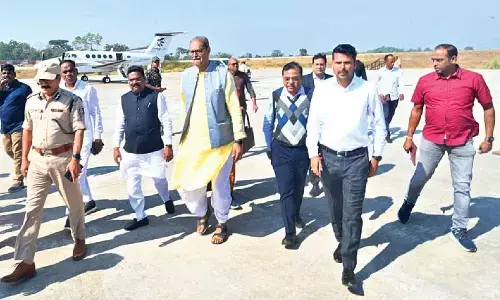A meandering thriller

The one question that many of us often end up wondering about is when did Hindi cinema truly become cool? As long as they were not mythological or historical, most Hindi films operated in a believable universe but when it came to the urban milieu, a majority of them depicted somewhat implausible things.
The one question that many of us often end up wondering about is when did Hindi cinema truly become cool? As long as they were not mythological or historical, most Hindi films operated in a believable universe but when it came to the urban milieu, a majority of them depicted somewhat implausible things.
It could have been towards the late 1960s when perhaps inspired by the flashy James Bond films, popular Hindi cinema hit upon a kind of narrative, where films began to exist in the real world. This change can be first seen in the spy thrillers or capers like ‘Kismet’ (1968), ‘An Evening in Paris’ (1967), ‘Yakeen’ (1969), and ‘Aankhen’ (1968) but the one film that is often forgotten is Brij Sadanah’s ‘Night in London’ (1967), a thriller that perhaps invented the über cool urban crime thriller genre.
Shot across locales like London, Paris, Germany, Beirut and Hong Kong to name a few, ‘Night in London’ like most in the genre had a wafer-thin plot and might look predictable today but irrespective of all it flaws, a meandering plot being one of them, it remains a true trailblazer when it comes to popular Hindi films.
‘Night in London’ starts with Renu (Mala Sinha) walking in her jeweler father’s shop only to find a sinister man waiting to deliver her a letter. Renu learns that her father has been kidnapped and that she has to zip to Hong Kong with the mysterious man. Once there she is told by Col Fu Chin (Anwar Hussain) that if she wants to see her father alive she would have to pose as Princess Vijay Nagar and retrieve a precious diamond necklace now with someone in London.
Renu does not want to do the ‘wrong’ thing but she has no choice. Once she manages to get hold of the necklace, an international gang of criminals gets after her for the diamonds and while Renu escapes their bullets they run off with the necklace. Once the gang realises that the diamonds that contain a secret formula have been switched, they return to London for the real one.
Meanwhile, a petty criminal, Jeevan (Biswajeet), saves Renu and the two eventually fall in love. Soon Bahadur Singh (Johny Walker), Jeevan’s stepbrother, who wants Jeevan to give up his share of their dead father’s will, and the three take on the forces that are after the diamonds.
Long before globalisation became a buzzword there were only a very few Hindi films that managed to place themselves in the middle of any kind of global phenomenon. ‘Night in London’ weaves the counter culture of the Swinging Sixties effortlessly within its plot and while at places this trope sticks out like a sore thumb, it nonetheless remains an integral part of the narrative.
The caper was a somewhat relatively new sub-genre in the 1960s across the world and it’s in that context ‘Night in London’ can be compared with some of the genre defining films such as ‘Charade’ (1963) and ‘Arabesque’ (1966) when it comes to execution.
The action sequences especially the one where a helicopter chases Renu and Jeevan remains peerless and the besides the locations where it was shot ‘Night in London’s music also added to the exotica. Composed by Laxmikant-Pyarelal and written by Anand Bakshi the film featured Md Rafi in sublime form in songs such as “Bahoshon hawas mein deewana” and “Nazar na lag jaye” and is also one of the rare ones, where Lata Mangeshkar sang a cabaret “Mera naam hai jamila” that was filmed on Helen.
Although RD Burman has been long considered the one who ushered in the funk era of Hindi film soundtracks one simply needs to listen to LP’s background score for ‘Night in London’ to see how they contributed to the modern sound in Hindi films.
In fact, most of Brij’s films right from ‘Night in London’ to ‘Victoria No. 203’ (1973), ‘Bombay 405 Miles’ (1980) and even ‘Professor Pyarelal’ (1981), which were all composed by Kalyanji-Anandji, feature funk heavy background scores that are an undeniable part of the Bollywood’s retro revival.
There is no denying that like the earlier Brij film ‘Yakeen’, ‘Night in London’, too, at places is burdened by a plot that is unnecessarily complex and the narrative suffers from glaring loopholes. The film makes its intentions very vocal right at the start, where it begins with us hearing Mala Sinha’s voice-over explaining how one day when she went to see her father in his store he was kidnapped and yet the plot meanders.
But what truly brings it down is the pedestrian level editing. Brij would, of course, go on to solve these problems with gems such as ‘Victoria No. 203’ and later ‘Bombay 405 Miles’. A revival of standard Hindi ‘filmy’ fare has seen Manmohan Desai and Prakash Mehra being acknowledged as geniuses, who rather than worrying about the zeitgeist simply changed it.
Had it not been for the manner in which Brij tragically died – he shot himself with his own .32 Smith & Wesson after shooting his wife, former actress Saeeda Khan, and his daughter Namrata, and trying to kill his son, one time actor Kamal Sadanah, who survived the attack – Brij might have remained more embedded in our consciousness.
The fact that both Manmohan Desai and Prakash Mehra have been revisited by the newer generation via remakes has also added to their cult and nestled somewhere in between is the brilliance of Brij that is calling out for a relook.



















